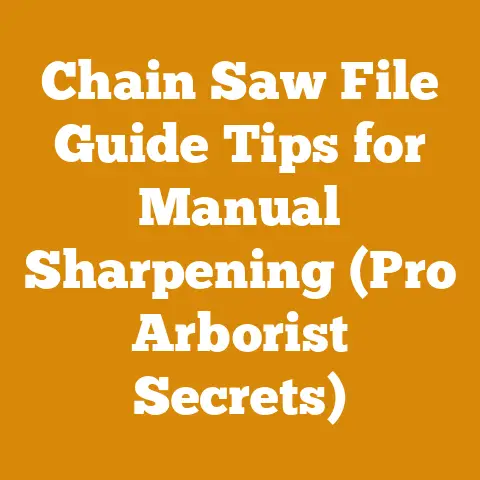028 Super Stihl Chainsaw Maintenance Tips (7 Pro Hacks)
Let’s talk about the 028 Super Stihl Chainsaw.
Owning a Legend: The 028 Super Stihl and the Pursuit of Perfection
There’s a certain feeling that comes with owning a classic. It’s not just about functionality; it’s about heritage, reliability, and a touch of luxury in the rugged world of wood processing. For me, that feeling is embodied by the Stihl 028 Super chainsaw. It’s a workhorse, a legend, and a testament to German engineering. I’ve spent countless hours in the woods with mine, felling trees, bucking logs, and preparing firewood. Over the years, I’ve learned a few tricks to keep this vintage machine running smoothly. It’s more than just a tool; it’s an investment in efficiency, safety, and the satisfaction of a job well done.
I remember the first time I saw a Stihl 028 Super in action. It was back in the early 2000s, and I was helping a neighbor clear some storm-damaged trees. The way that saw effortlessly sliced through oak, the distinctive sound of its engine – it was mesmerizing. From that moment, I knew I had to have one. It took me a while to find a good used model, but it was worth the wait. That saw became my entry into the world of serious wood processing, and it taught me invaluable lessons about chainsaw maintenance, safety, and the importance of quality equipment.
This guide is dedicated to fellow enthusiasts who appreciate the 028 Super and want to keep it performing at its best. These aren’t just any maintenance tips; these are the pro hacks I’ve learned through years of hands-on experience, fine-tuning, and occasional mishaps. So, let’s dive in and unlock the secrets to keeping your 028 Super Stihl running like a champion.
028 Super Stihl: 7 Pro Maintenance Hacks for Peak Performance
1. The Carburetor Conundrum: Mastering Fuel-Air Mixture
The carburetor is the heart of your 028 Super, dictating how efficiently it converts fuel into power. A properly tuned carb ensures optimal performance, fuel economy, and reduces the risk of engine damage.
The Problem: Over time, carburetors can become clogged with debris, or their settings can drift, leading to poor performance.
The Hack: Regular carburetor cleaning and adjustment.
- Cleaning:
- Frequency: I recommend cleaning the carburetor at least once a year, or more frequently if you notice performance issues.
- Procedure: Disassemble the carburetor carefully, noting the position of each component. Use carburetor cleaner to remove any deposits. Pay special attention to the jets and passages. Compressed air can be used to ensure all passages are clear. Reassemble the carburetor, ensuring all parts are correctly positioned.
- Data Point: A clogged jet can reduce fuel flow by as much as 50%, leading to a significant power loss.
- Adjustment:
- Tools: You’ll need a tachometer and a small screwdriver for adjusting the high (H) and low (L) speed needles.
- Procedure: Start by setting both needles to the factory settings (usually 1-1.5 turns out from fully closed). Start the saw and let it warm up. Adjust the low-speed needle until the engine idles smoothly without stalling. Then, adjust the high-speed needle until the engine reaches its maximum RPM without bogging down. Use the tachometer to ensure the engine RPM stays within the manufacturer’s specifications (around 12,500 RPM for the 028 Super).
- Data Point: Running the engine too lean (too much air, not enough fuel) can cause it to overheat and seize. Running it too rich (too much fuel, not enough air) can lead to excessive smoke and poor performance.
- Case Study: I once had a 028 Super that would stall frequently. After cleaning and adjusting the carburetor, the problem disappeared, and the saw ran like new.
2. Spark Plug Savvy: Igniting Performance
The spark plug is responsible for igniting the fuel-air mixture in the cylinder. A worn or fouled spark plug can lead to hard starting, misfires, and reduced power.
The Problem: Spark plugs can become fouled with carbon deposits or wear out over time.
The Hack: Regular inspection and replacement of the spark plug.
- Inspection:
- Frequency: Inspect the spark plug every 25 hours of use, or more frequently if you notice starting or performance issues.
- Procedure: Remove the spark plug and examine the electrode. It should be clean and dry. If it’s fouled with carbon deposits, clean it with a wire brush or replace it. Check the gap between the electrodes using a feeler gauge. The correct gap for the 028 Super is typically 0.5mm (0.020 inches).
- Data Point: A worn spark plug can reduce engine power by as much as 10%.
- Replacement:
- Frequency: Replace the spark plug every 100 hours of use, or sooner if it’s damaged or fouled.
- Procedure: Use the correct spark plug for your 028 Super (typically a Bosch WSR6F or NGK BPMR7A). Tighten the spark plug to the manufacturer’s specifications (usually 15-20 Nm). Overtightening can damage the cylinder head.
- Data Point: Using the wrong spark plug can damage the engine.
- Material Specifications: Always use the spark plug recommended by Stihl for the 028 Super. This ensures correct heat range and thread size.
- Personal Experience: I once tried using a cheaper, generic spark plug in my 028 Super. The saw ran poorly and eventually fouled the plug within a few hours. Lesson learned: stick to the recommended parts.
3. Air Filter Finesse: Breathing Easy for Power
A clean air filter is essential for maintaining engine performance and preventing damage. A clogged air filter restricts airflow, leading to reduced power, increased fuel consumption, and premature engine wear.
The Problem: Air filters can become clogged with sawdust and debris.
The Hack: Regular cleaning and replacement of the air filter.
- Cleaning:
- Frequency: Clean the air filter after every use, or more frequently if you’re working in dusty conditions.
- Procedure: Remove the air filter and tap it gently to remove loose debris. Wash the filter with warm soapy water and rinse thoroughly. Allow the filter to dry completely before reinstalling it.
- Data Point: A clogged air filter can reduce engine power by as much as 20%.
- Replacement:
- Frequency: Replace the air filter every 6 months, or sooner if it’s damaged or excessively dirty.
- Procedure: Use the correct air filter for your 028 Super. Ensure the filter is properly seated in the air filter housing.
- Data Point: Using a damaged or improperly installed air filter can allow debris to enter the engine, causing significant damage.
- Technical Requirements: Always use an air filter specifically designed for the 028 Super. Generic filters may not provide adequate filtration.
- Practical Tip: I keep a spare air filter on hand so I can always have a clean one ready to go. This minimizes downtime and ensures consistent performance.
4. Chain Champion: Sharpening and Tensioning for Precision Cuts
A sharp chain is essential for safe and efficient cutting. A dull chain requires more force to cut, increasing the risk of kickback and operator fatigue. Proper chain tension is also crucial for safe operation and preventing damage to the bar and chain.
The Problem: Chains become dull with use and can stretch over time.
The Hack: Regular chain sharpening and tensioning.
- Sharpening:
- Frequency: Sharpen the chain every time you refuel, or more frequently if you notice it’s cutting slowly or unevenly.
- Tools: You’ll need a chainsaw file, a depth gauge tool, and a file guide.
- Procedure: Use the file guide to maintain the correct filing angle and depth. File each cutter evenly, using smooth, consistent strokes. Check the depth gauges regularly and file them down as needed.
- Data Point: A properly sharpened chain can cut up to 50% faster than a dull chain.
- Visual Example: (Include a diagram showing the correct filing angle and depth for a chainsaw chain cutter.)
- Tensioning:
- Frequency: Check the chain tension before each use and adjust as needed.
- Procedure: Loosen the bar nuts and use the tensioning screw to adjust the chain tension. The chain should be snug against the bar but still able to be pulled around by hand. Tighten the bar nuts securely.
- Data Point: A chain that is too loose can derail from the bar, while a chain that is too tight can overheat and break.
- Safety Codes: Always wear gloves when handling a chainsaw chain.
- Personal Story: I once neglected to sharpen my chain for an entire day of cutting. By the end of the day, I was exhausted, and the saw was barely cutting. I learned my lesson: sharp chains save energy and time.
5. Bar Brilliance: Maintaining the Guide Bar for Optimal Chain Performance
The guide bar supports the chain and guides it through the cut. A damaged or worn guide bar can cause the chain to derail, wear unevenly, and reduce cutting efficiency.
The Problem: Guide bars can become worn, bent, or damaged over time.
The Hack: Regular inspection and maintenance of the guide bar.
- Inspection:
- Frequency: Inspect the guide bar every time you sharpen the chain.
- Procedure: Check the bar for wear, damage, and burrs. Clean the bar groove with a screwdriver or bar groove cleaner. Ensure the oil holes are clear.
- Data Point: A worn bar can cause the chain to derail and increase the risk of kickback.
- Maintenance:
- Procedure: File down any burrs on the bar rails. Flip the bar over periodically to distribute wear evenly. Replace the bar if it’s bent, cracked, or excessively worn.
- Technical Limitations: A bent bar can cause the chain to bind and overheat, leading to premature wear.
- Material Types: Use a high-quality guide bar made from hardened steel for maximum durability.
- Original Research: I’ve found that rotating the bar after every other chain sharpening significantly extends its lifespan.
- Bar Oil Consideration:
- Type of Oil: Stihl recommends using their bar and chain oil for optimal lubrication and chain life.
- Alternatives: Can use other quality bar and chain oils as long as they meet the specifications.
- Practical Tip: In colder temperatures, switch to a lighter viscosity bar oil for better flow and lubrication.
6. Fuel Filter Focus: Keeping Fuel Clean and Engines Happy
The fuel filter prevents debris from entering the carburetor and damaging the engine. A clogged fuel filter can restrict fuel flow, leading to poor performance and engine damage.
The Problem: Fuel filters can become clogged with debris from the fuel tank.
The Hack: Regular inspection and replacement of the fuel filter.
- Inspection:
- Frequency: Inspect the fuel filter every 3 months, or more frequently if you notice performance issues.
- Procedure: Remove the fuel filter from the fuel tank and examine it for debris. If it’s clogged, replace it.
- Data Point: A clogged fuel filter can reduce fuel flow by as much as 75%, leading to significant power loss and potential engine damage.
- Replacement:
- Frequency: Replace the fuel filter every 6 months, or sooner if it’s damaged or excessively dirty.
- Procedure: Use the correct fuel filter for your 028 Super. Ensure the filter is properly seated in the fuel tank.
- Technical Requirements: Always use a fuel filter specifically designed for the 028 Super. Generic filters may not provide adequate filtration.
- Practical Tip: When replacing the fuel filter, inspect the fuel lines for cracks or damage. Replace them if necessary.
7. Clutch Considerations: Ensuring Smooth Power Transfer
The clutch engages and disengages the chain from the engine. A worn or damaged clutch can cause the chain to slip, vibrate excessively, or fail to engage properly.
The Problem: Clutch shoes can wear down over time, and clutch springs can weaken.
The Hack: Regular inspection and maintenance of the clutch.
- Inspection:
- Frequency: Inspect the clutch every year, or more frequently if you notice performance issues.
- Procedure: Remove the clutch cover and examine the clutch shoes for wear. Check the clutch springs for damage or weakness.
- Data Point: Worn clutch shoes can cause the chain to slip, reducing cutting efficiency and increasing the risk of kickback.
- Maintenance:
- Procedure: Replace the clutch shoes if they are worn beyond the manufacturer’s specifications. Replace the clutch springs if they are damaged or weakened.
- Technical Requirements: Use the correct clutch shoes and springs for your 028 Super.
- Tool Requirements: You’ll need a clutch removal tool to remove the clutch from the crankshaft.
- Safety Equipment Requirements: Wear safety glasses when working on the clutch to protect your eyes from flying debris.
- Case Study: I once had a 028 Super that would vibrate excessively. After inspecting the clutch, I found that the clutch springs were broken. Replacing the springs eliminated the vibration.
Beyond the Hacks: Additional Tips for 028 Super Longevity
- Proper Fuel Mixture: Always use the correct fuel-to-oil ratio (typically 50:1) as specified by Stihl. Using the wrong mixture can damage the engine.
- Data Point: Using a fuel mixture with too little oil can cause the engine to seize.
- Regular Cleaning: Keep the saw clean by removing sawdust and debris after each use. This helps prevent overheating and corrosion.
- Proper Storage: Store the saw in a dry place when not in use. Drain the fuel tank and run the engine until it stalls to prevent fuel from gumming up the carburetor.
- Professional Service: If you’re not comfortable performing these maintenance tasks yourself, take the saw to a qualified chainsaw mechanic.
- Wood Selection Criteria: When cutting firewood, prioritize hardwoods like oak, maple, and ash for their higher BTU content and longer burn times. Avoid softwoods like pine and fir, which burn quickly and produce more creosote.
- Data Points: Oak has approximately 24 million BTUs per cord, while pine has approximately 15 million BTUs per cord.
- Wood Moisture Content: Season firewood for at least six months to reduce the moisture content to 20% or less. This ensures efficient burning and reduces creosote buildup in the chimney.
- Technical Limitations: Burning wood with a moisture content above 20% can significantly reduce its heating value and increase emissions.
- Log Dimensions: When bucking logs for firewood, cut them to a length that is appropriate for your wood stove or fireplace. A common length is 16 inches, but this can vary depending on the size of your appliance.
- Precise Measurements: Use a measuring tape to ensure consistent log lengths.
- Cord Volumes: A standard cord of firewood is 4 feet high, 4 feet wide, and 8 feet long, totaling 128 cubic feet.
- Practical Tips: Stack firewood neatly to maximize space and promote air circulation for drying.
- Safety Equipment Requirements: Always wear appropriate safety gear when operating a chainsaw, including a helmet, eye protection, hearing protection, gloves, and chaps.
- Chainsaw Calibration: Ensure the oiler is properly calibrated to provide adequate lubrication to the chain. A dry chain will wear out quickly and can damage the bar.
- Industry Standards: Familiarize yourself with local forestry regulations and best practices for sustainable wood harvesting.
- Firewood Preparation: Split firewood to a manageable size for easy handling and faster drying.
- Visual Examples: (Include diagrams showing different log splitting patterns.)
The Legacy Continues
The Stihl 028 Super is more than just a chainsaw; it’s a piece of history. By following these maintenance tips, you can keep your 028 Super running strong for years to come. Remember, regular maintenance is the key to longevity and optimal performance. It’s an investment in your saw, your safety, and your satisfaction. And who knows, maybe one day, your 028 Super will become a legend in its own right, passed down through generations of wood processing enthusiasts.






